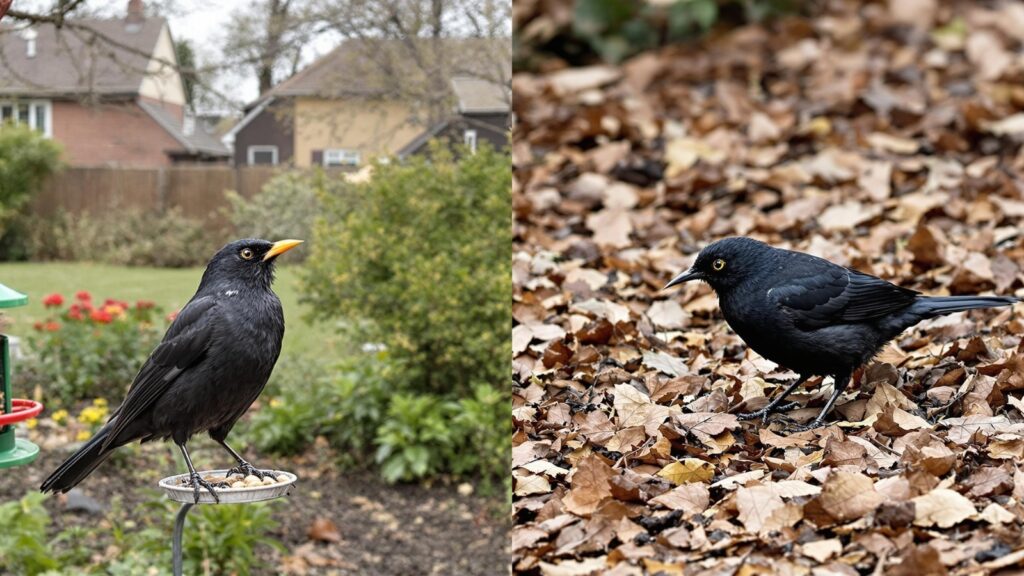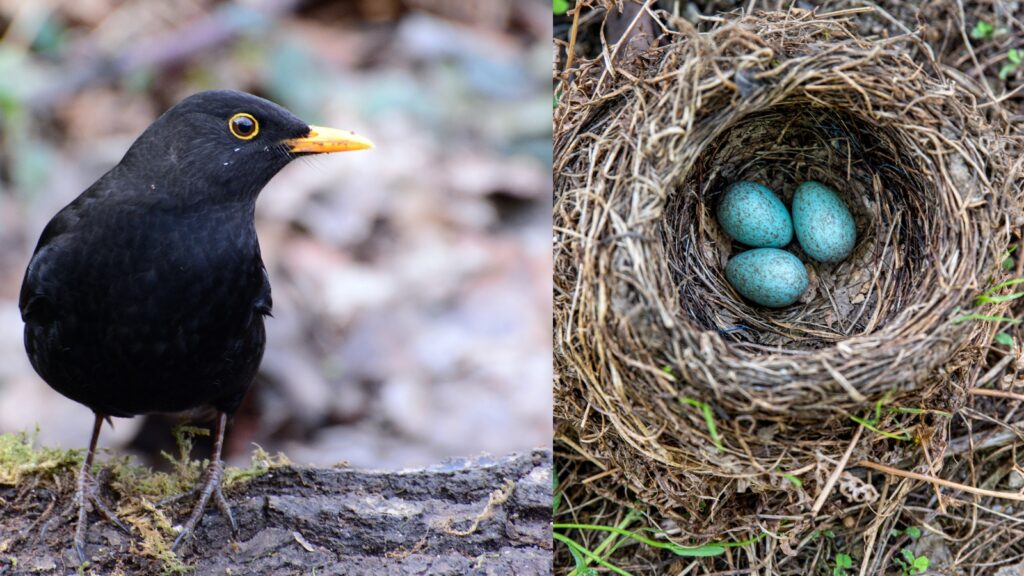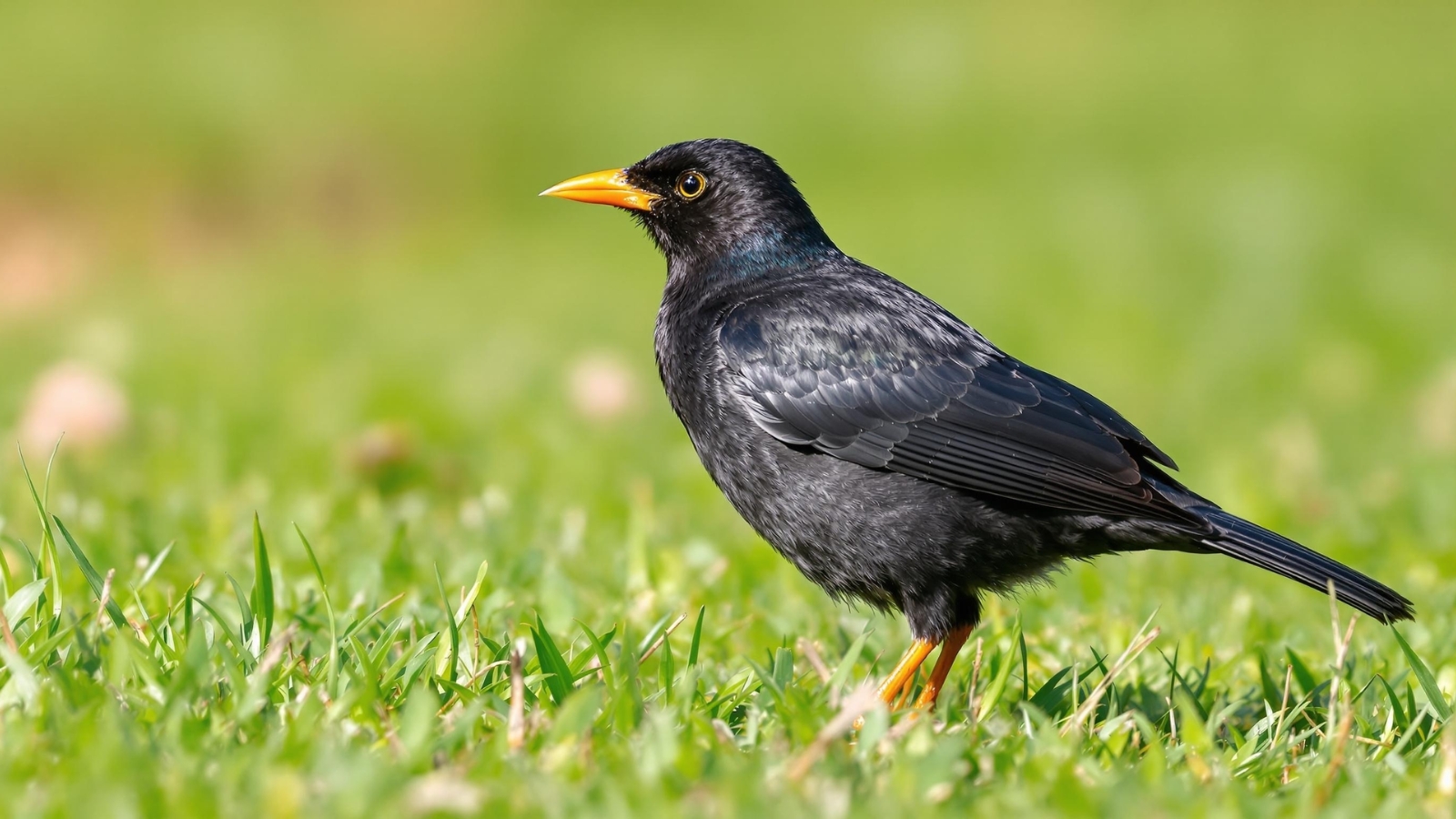Blackbirds typically live for 2-4 years in the wild, with an average life expectancy of 3.4 years. However, the oldest recorded blackbird lived to an impressive 21 years and 10 months. Captive blackbirds can survive up to 20 years when protected from natural threats and provided with consistent food sources.
Understanding how long blackbirds live provides fascinating insights into avian survival in both urban and rural environments. These familiar garden visitors face numerous challenges throughout their lives, from predation to environmental hazards, yet remain one of Britain’s most successful bird species. This comprehensive guide explores blackbird lifespan variations, mortality factors, and the remarkable differences between average life expectancy and maximum recorded ages.
You’ll discover why most blackbirds don’t survive their first year, what threatens their survival at different life stages, and how human activity impacts their longevity. We’ll also examine the stark contrast between wild and captive lifespans, breeding patterns that compensate for high mortality, and practical ways to support blackbird populations in your garden.
Key Takeaways
- Average lifespan in the wild is 3.4 years, though many die within their first year
- The oldest recorded wild blackbird reached 21 years and 10 months
- First-year mortality is extremely high, with only 37% of young blackbirds reaching adulthood
- Captive blackbirds can live up to 20 years due to protection from predators and consistent food
- Year-on-year survival rates for adult blackbirds range from 40-70%
- Blackbirds compensate for high mortality with multiple broods, producing up to 4 clutches per breeding season.
Average Lifespan of Blackbirds in the Wild
The typical wild blackbird lifespan presents a sobering picture of survival in nature. Common or European blackbirds (Turdus merula) face a challenging existence from the moment they hatch, with the average bird living just 3.4 years in the UK. This relatively short life expectancy reflects the harsh realities of predation, disease, and environmental hazards that these birds encounter daily.
Mortality statistics paint a stark picture of blackbird survival challenges. Approximately 50% of all blackbird nests fail before chicks even fledge, meaning half of all blackbirds never leave the nest alive. For those that do survive to fledging, the outlook remains precarious – studies indicate that most blackbird deaths occur within the first few weeks after leaving the nest, when young birds are still developing crucial survival skills.
The year-on-year survival rate for adult blackbirds hovers between 40% and 70%, depending on environmental conditions and location. This means that in any given year, between 3 and 6 out of every 10 adult blackbirds will not survive to the following breeding season. Urban blackbird populations typically show slightly higher survival rates than their rural counterparts, likely due to supplementary feeding in gardens and milder winter conditions in built-up areas.
Maximum Recorded Lifespan
While the average blackbird faces a brief existence, exceptional individuals demonstrate the species’ potential for longevity records. The oldest Common blackbird ever documented through bird ringing schemes lived an astounding 21 years and 10 months – more than six times the average lifespan. Another remarkable individual reached 20 years and 3 months, whilst multiple blackbirds have been recorded surviving beyond 15 years.
These exceptional blackbird ages reveal that biological ageing isn’t the primary limiting factor for blackbird survival. Rather, external threats and environmental pressures typically claim birds long before they reach their natural lifespan potential. The dramatic gap between average and maximum lifespans – from 3.4 years to over 20 years – illustrates how successfully avoiding predators, disease, and accidents can extend a blackbird’s life dramatically.
North American blackbird species show similar patterns of longevity in blackbirds. The Red-winged blackbird’s oldest recorded individual reached 15 years and 9 months, demonstrating that various blackbird species share comparable maximum lifespan potentials despite facing different environmental challenges across continents.
Factors Affecting Blackbird Mortality
Predation represents the single greatest threat to blackbird survival throughout their lives. Domestic and feral cats alone account for billions of bird deaths annually, with ground-feeding species like blackbirds particularly vulnerable. Natural predators including sparrowhawks, magpies, weasels, and stoats also take a significant toll, especially on eggs, nestlings, and fledglings in their exposed cup nests.
Human-caused mortality adds substantially to natural death rates. Window strikes claim hundreds of millions of birds yearly, whilst vehicle collisions represent another major hazard for low-flying blackbirds. Pesticide exposure, both direct and through contaminated prey, contributes to mortality, as does habitat loss from urban development and agricultural intensification. Light pollution disorients migrating blackbirds, increasing collision risks and exhaustion.
Environmental factors significantly impact survival rates across seasons. Harsh winters with frozen ground prevent blackbirds from accessing their primary food source – earthworms. Conversely, hot, dry summers create similar feeding difficulties and can prevent late broods. Spring weather during the breeding season proves critical, with cold, wet conditions reducing insect availability for chicks and increasing energy demands on breeding adults.
Life Stages and Survival Rates
The nestling stage represents the most perilous period in a blackbird’s life. With approximately 50% nest failure rates, half of all blackbird eggs never produce fledglings. Predation accounts for much of this loss, as blackbirds build open cup nests in relatively exposed locations. Weather extremes, parental inexperience, and human disturbance contribute additional mortality pressures during the 14-day incubation and 14-day nestling period.
Fledgling survival remains critically low even after successfully leaving the nest. The first three weeks post-fledging prove especially dangerous, as young blackbirds must develop flight skills, learn predator avoidance, and master foraging techniques whilst still partially dependent on parents. Studies show that heavier fledglings and those leaving the nest earlier in the season enjoy significantly better survival prospects. Only about 37% of fledglings ultimately reach breeding age.
Once blackbirds achieve adult survival rates, their prospects improve modestly. Adult birds demonstrate year-on-year survival rates between 40-70%, with experienced breeders typically showing higher survival than first-year adults. Seasonal mortality patterns reveal that spring breeding season and winter represent the highest-risk periods, whilst autumn typically shows the lowest mortality rates as food remains abundant and breeding stress has passed.

Captivity vs Wild Lifespan
The dramatic difference between wild and captive blackbird longevity illustrates how environmental pressures limit natural lifespans. Whilst wild blackbirds average just 3.4 years, captive individuals routinely reach 15-20 years when provided with consistent food, veterinary care, and protection from predators. This six-fold increase in lifespan demonstrates that blackbirds possess the biological capacity for much longer lives than typically achieved in nature.
Protected environments eliminate the primary mortality factors affecting wild blackbirds. Captive birds face no predation risk, receive treatment for parasites and diseases, enjoy reliable year-round food supplies, and avoid hazards like window strikes or vehicle collisions. Additionally, captive blackbirds don’t experience the energetic costs of breeding, territory defence, or migration that stress wild populations.
However, blackbird captivity remains rare outside rehabilitation settings, as these birds aren’t typically kept as pets. The lifespan differential primarily serves to highlight how successfully managing threats in wild populations, through predator control, supplementary feeding, and habitat improvement, could potentially extend average lifespans closer to their biological maximum.
Breeding and Population Sustainability
Despite high mortality rates, blackbirds maintain stable populations through remarkable reproductive strategies. These prolific breeders can produce 2-4 broods annually between March and August, with each clutch containing 3-5 eggs. This high reproductive output compensates for the severe losses at every life stage, ensuring population sustainability despite individual birds’ short lives.
Female blackbirds demonstrate efficient breeding patterns by often leaving fledgling care to males whilst immediately beginning construction of the next nest. This division of labour enables pairs to maximise breeding attempts within the limited season. Early-season broods typically show higher success rates due to abundant food, mild weather, and lower predator activity, encouraging blackbirds to begin breeding as early as conditions permit.
Population dynamics reveal how blackbirds’ fast lifecycle enables rapid recovery from localised population crashes. Young birds can breed at just one year old, and successful pairs might produce 15-20 offspring in a single season.
Even with high mortality, just two surviving offspring per pair maintains population stability. This reproductive resilience has enabled blackbirds to remain one of Britain’s most common birds despite facing numerous modern threats.
Seasonal Variations in Mortality
Winter mortality peaks when frozen ground prevents blackbirds from accessing earthworms, their primary food source. During severe cold snaps, blackbirds can survive only 2-3 days without food before succumbing to starvation. Urban blackbirds often fare better during winter due to garden feeding stations and the warmer microclimate of built environments. Supplementary feeding during cold periods can dramatically improve local survival rates.
The breeding season brings different mortality pressures, particularly for adult birds. Males face increased predation risk whilst singing from exposed perches to defend territories. Both sexes experience energetic stress from repeated breeding attempts, with females particularly vulnerable during incubation.
Spring weather variability can cause sudden food shortages, leading to brood failure and adult mortality when parents exhaust themselves attempting to feed chicks.
Migration risks affect northern European blackbird populations that winter in the UK. These birds face additional mortality during long flights, including exhaustion, disorientation, and increased predation vulnerability. Collision risks with buildings and vehicles spike during migration periods, whilst unfamiliar territories expose migrants to new threats. However, migration allows birds to escape harsh continental winters, potentially improving overall survival despite journey risks.
Geographic Differences in Lifespan
Urban vs rural survival rates show interesting patterns, with city blackbirds often demonstrating higher year-round survival despite facing unique urban hazards. Urban populations benefit from milder winters, abundant supplementary food from gardens, and reduced natural predator populations. However, they face increased risks from cats, window strikes, and vehicle collisions. The net effect typically favours urban birds, particularly during harsh winters.
Regional variations across the UK reflect differences in climate, predator densities, and habitat quality. Scottish blackbirds face harsher winters but lower cat densities, whilst southern English populations enjoy milder weather but intense predation pressure in densely populated areas. Coastal populations may benefit from more stable temperatures but face exposure risks during storms.
International comparisons reveal broadly similar lifespans across the blackbird’s range, though specific threats vary. Mediterranean populations avoid harsh winters but face intense summer heat and drought. Scandinavian blackbirds endure extreme cold but benefit from lower human population density and reduced urban threats.
These geographic patterns highlight how local environmental conditions shape survival probabilities, whilst overall lifespan potential remains consistent.

Conservation and Supporting Blackbird Longevity
Creating blackbird-friendly gardens represents the most effective individual conservation action. Providing berry-bearing shrubs like hawthorn and elder offers natural food sources, whilst maintaining leaf litter and compost areas ensures earthworm availability. Dense shrubs and climbers provide safe nesting sites away from predators. Avoiding pesticide use protects both blackbirds and their invertebrate prey from toxic exposure.
Feeding recommendations can significantly boost local blackbird survival, particularly during winter and breeding seasons. Mealworms, both live and dried, provide essential protein for breeding birds and their chicks. Soaked sultanas, apple pieces, and specialised ground-feeding blends suit blackbirds’ feeding behaviour. Consistent feeding throughout harsh weather prevents starvation during critical periods when natural food becomes inaccessible.
Habitat improvements at landscape scales offer the greatest potential for increasing blackbird survival rates. Maintaining hedgerows provides corridors for safe movement and nesting opportunities. Creating wild edges in parks and gardens offers foraging areas whilst reducing collision risks. Installing window decals, keeping cats indoors during fledgling season, and driving cautiously in residential areas all contribute to reducing human-caused mortality.
Conclusion
Understanding blackbird lifespans reveals a complex picture of survival against numerous odds. Whilst these familiar garden birds average just 3.4 years in the wild, exceptional individuals prove they can live over 20 years when threats are minimised.
The dramatic difference between average and maximum lifespans highlights how predation, human hazards, and environmental pressures, rather than biological ageing, primarily limit blackbird longevity.
The species’ remarkable reproductive capacity, producing multiple broods annually, compensates for high mortality rates and maintains stable populations despite individual birds’ brief lives. By understanding the factors that influence blackbird survival, from nestling vulnerability to seasonal food shortages, we can take practical steps to support these charismatic birds.
Simple actions like providing safe garden habitats, appropriate supplementary food, and reducing hazards can help more blackbirds approach their true lifespan potential.
Frequently Asked Questions
Q: What is the average lifespan of a blackbird?
A: The average lifespan of a blackbird in the wild is 3.4 years, though many die within their first year of life due to high nestling and juvenile mortality rates.
Q: Can blackbirds live for 20 years?
A: Yes, whilst extremely rare, the oldest recorded wild blackbird lived for 21 years and 10 months. Blackbirds in captivity can also reach 20 years with proper care.
Q: Why do blackbirds have such short lives?
A: High predation from cats and natural predators, window strikes, vehicle collisions, harsh weather, and food scarcity during winter all contribute to their short average lifespan.
Q: Do male and female blackbirds live equally long?
A: Research suggests similar survival rates for both sexes, though males face slightly higher risks during breeding season from territorial disputes and exposed singing positions.
Q: How many baby blackbirds survive to adulthood?
A: Only about 37% of blackbird fledglings survive to breeding age, with 50% of nests failing completely and many young birds dying in their first few weeks after fledging.
Q: Do urban blackbirds live longer than rural ones?
A: Urban blackbirds often show slightly higher survival rates due to milder winters and supplementary garden feeding, despite facing increased risks from cats and traffic.
Q: What percentage of blackbirds survive each year?
A: Adult blackbirds have a year-on-year survival rate between 40-70%, meaning 3-6 out of every 10 adult birds die annually.
Q: How can I help blackbirds live longer in my garden?
A: Provide berry-bearing plants, maintain leaf litter for earthworms, offer mealworms during breeding season, keep cats indoors during fledgling period, and install window strike preventers.
Q: Do blackbirds die of old age?
A: Rarely – most blackbirds die from predation, accidents, or starvation long before reaching their biological lifespan limit of around 20 years.
Q: What season has the highest blackbird mortality?
A: Winter and early spring typically show the highest mortality due to food scarcity, whilst the breeding season also poses risks from exhaustion and increased predation.
Q: How does blackbird lifespan compare to other garden birds?
A: Blackbirds have similar lifespans to other medium-sized garden birds like thrushes and starlings, living longer than small birds like robins but shorter than larger species like crows.
Q: Can blackbirds survive without food for long?
A: Blackbirds can only survive 2-3 days without food, making consistent food availability crucial during harsh weather conditions.
Further Reading:
- Wysocki, D., Witkowska, M., & Walczakiewicz, S. (2023). Factors affecting fledglings survival in urban population of European blackbirds in Szczecin (NW Poland). Scientific Reports, 13, 18723. Highly authoritative recent study in Nature’s Scientific Reports with specific focus on blackbird survival rates
- British Trust for Ornithology (BTO) – Blackbird Lifecycle and Statistics (2023) Premier ornithological research organization with specific blackbird data; high domain authority
- Royal Society for the Protection of Birds (RSPB) – Blackbird Species Information (2024) Extremely high domain authority conservation organization with current blackbird information.
